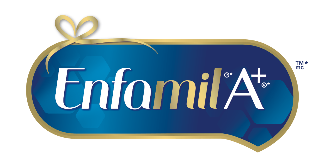Learn how DHA—a building block of the brain—is important for infant brain development. DHA, or docosahexaenoic acid, is an omega-3 fat found throughout our bodies, but it’s most abundant in our brains. Get to know the relationship between DHA and mental development in infancy, how DHA can support eye development and ways to incorporate DHA into your infant’s diet.
Why Is DHA Important for Babies?
DHA supports normal brain and eye development, which may help your baby achieve developmental milestones like smiling, crawling, walking and grasping. DHA is an important building block of the brain.
Infant Brain Development
Infant brain development is rapid well into baby’s first three years of age. Your baby’s brain will double in size by their first birthday, and they’ll go from simply adjusting to life outside the womb to showing you their favourite toys and exploring the world around them. Experts recommend ensuring that your infant’s nutrition contains DHA to support brain growth, which will be about 85% complete by your child’s third birthday.
Your baby’s brain will never grow this fast again.
DHA and brain development go hand-in-hand; when you give your child DHA, you help their normal physical brain development.
Infant Eyesight Development
DHA also helps infant eye development. Our retinas are rich in DHA, and vision is a critical part of focus. Babies are born near-sighted, but by five months old, vision and depth perception improve.1 They’ll see in three dimensions and start to know a favourite teddy bear is still their teddy bear, even when it’s upside down.
DHA helps infant eyesight development
When your baby is born, they can focus best on people and things that are close to them, but by five months, your baby’s vision rapidly develops and they’ll gain the ability to focus on objects that are farther away.1
How Does My Baby Get DHA?
If you’re breastfeeding, your baby gets DHA from the foods you eat, but the amount depends on how much is in your diet. Only fatty fish and shellfish have significant amounts of DHA. To get enough DHA, breastfeeding moms need at least two servings of 75 grams (2.5 ounces) per week of fatty fish such as salmon, sardines, Atlantic mackerel and herring. You may also talk to your doctor about taking a DHA supplement.
Many infants also receive this important nutrient from formula with DHA. “If a woman is not breastfeeding her baby exclusively, she should choose an infant formula that contains DHA,” says Dr. Peter Nieman, an Alberta pediatrician. According to Dr. Bruce Holub, University Professor Emeritus and founder of the DHA/EPA Omega-3 Institute, clinical studies have shown that many infants given DHA have exhibited better cognitive performance, learning ability and visual acuity as compared to infants not provided with DHA.
Do All Infant Formulas Contain DHA?
No, and not all contain the same amount of DHA.
Check the formula’s ingredients. It will include about 11.5 mg/100 mL of DHA, which may be listed by its full name, docosahexaenoic acid. This level is similar to the average level in breast milk* and consistent with the recommendations of health experts, including the Dietitians of Canada.†

If you're using formula, consider DHA-enriched infant nutrition.
DHA-enriched infant formulas are an easy way to give your baby DHA. In fact, 9 out of 10 doctors prefer formulas with DHA as a practical way to support normal infant brain development during the first year of life.
Try DHA-enriched Enfamil A+
Enfamil A+® offers a full line of infant formulas with the same clinically proven level of DHA as found in Enfamil A+ Premium—our closest formula to breastmilk ever. DHA-enriched infant formulas provide an easy way to add DHA benefits to your child’s diet.
9 out of 10 doctors who would feed infant formula to their own children would use a DHA-enriched formula.
Some experts recommend that infant formula contain between 0.2 percent and 0.5 percent of total fatty acids. Enfamil A+ has a level of DHA recommended by global experts.

*Average level of DHA and ARA in worldwide breast milk is 0.32% and 0.47% (mean ± standard deviation of total fatty acids) based on an analysis of 65 studies of 2,474 women).
†Dietitians of Canada recommends that infants who are formula fed be given a formula in which DHA consists of at least 0.2% of total fatty acids.
Source:








